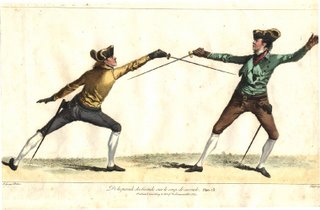




Regole di Molti Cauagliereschi Esercitii by Federico Ghisliero was first published in 1587 and joined a long line of European fencing manuals. There is very little information directly about this work or its author online. I presume that the heraldic miniature painting above is a bookplate of sorts.
One interesting sidenote to the publication - it was printed with about 30 blank pages and it appears that all of the illustrations were added by hand later, copied from a master draft. Hence, no 2 copies would have been the same; for those in which the sketches were actually added. The book is about 190 pages long and divided into theory and practise.
- The library at Bologna has posted all the illustrations online, available from the dropdown menu -- 'Ghislieri' -- at the Librit site; then click on the title to launch the viewing page.
- A message thread at Sword Forum International from a few years ago contains probably the best information around.
- A small article on eye focus during a duel from the self-styled Scholars of the Academie d'Espee of the fair Kingdom of Atlantia.
accoutrements to a 450 year old text, I chose on this occasion to remove them.]





Domenico Angelo (1717-1802) led something of an idyllic life. His wealthy merchant father supported his son's travels around their native Italy and Europe when Domenico was a young man.
During a 7 year stay in Paris, Angelo was privileged to receive training in horsemanship from Master equestrian: Monsieur de La Guerniere; learned dance from Gaetan Blathasar Vestris, the first dancer at the Paris Opera, and was instructed in fencing by the renowned Monsieur Teillagory. He also had an affair with the actress Peg Worthington who brought Angelo to England.
In England Angelo won some important fencing battles and established his School of Fencing, where the elite of British society gathered to learn swordsmanship and horse riding. The school was to remain in his family for generations and was still operating in the early 20th century.
Britain may have been something of a backwater in fencing instruction but Angelo's publishing in 1763 of his L'École des Armes, avec l'explication Générale des Principales Attitudes et Positions Concernant l'Escrime ('The school of fencing with a general explanation of the principal attitudes and positions peculiar to the art') was a watershed contribution in the history of fencing manuals. Diderot for instance published unedited sections and illustrations in his Encyclopédie.
- The best place to see the 47 colourful plates from L'École des Armes is at Donald A Head's Original Antique Books, Prints and Maps (thumbnail page).
- Another site with all the images - easier to see the illustrations as thumbnails perhaps but the larger images seem a bit lower in quality.
- How to Defend a Monopoly, or: Strategic Planning in Running a Salle by J. Christoph Amberger ~1996.
- The Society of 18th-Century Gentlemen on Fencing.
- Domenico Angelo THE SCHOOL OF FENCING Edited by Jared Kirby was recently re-released and is reviewed in The Times Literary Supplement.
(actually, there may be more semi-related posts --- another reason I need to go through the archives and post them all to del.icio.us. I guess the fact that I think about this more and more means that it is probably closer to being made manifest).



















2 comments :
Awwww brought back members of making wooden swords as kids, and running around my neighborhood living dungeons and dragons.... or Tom Hanks less popular "Mazes and Monsters"
I’d read about Henry Angelo in a biography of James Gillray: the fencing-master and the caricaturist were friends—so I was very interested to find out more about his father.
Post a Comment
Comments are all moderated so don't waste your time spamming: they will never show up.
If you include ANY links that aren't pertinent to the blog post or discussion they will be deleted and a rash will break out in your underwear.
Also: please play the ball and not the person.
Note: only a member of this blog may post a comment.